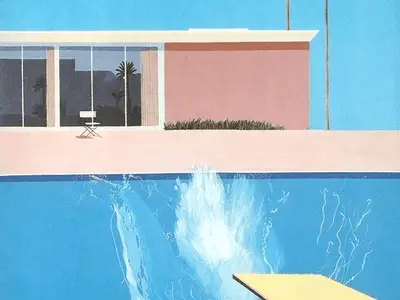A Bigger Splash by David Hockney
Date: 1967
Media: Oil
Style: Pop Art
Size: 242.5 cm x 243.9 cm

A Bigger Splash is a large pop art painting by British artist David Hockney. Measuring 242.5 centimetres by 243.9 centimetres in a square format with a wide border.
The painting depicts a swimming pool with a diving board, a wide deep patio with a single deckchair in front of a partial building of a single floor. The front of the building is mainly large panes of glass which reflects a larger building also with palm trees. To the right, in front of the blank wall is a row of low shrubs and further to the right are two tall palm trees against a blue sky.
The lower half of the painting is dominated by the flat blue water of the pool and the large splash of water. An unseen diving figure creates the splash, entering the water at a time and point where the figure is unseen below the surface. The diving board protrudes from the bottom right of the painting. The far side of the pool is edged in a thin deeper blue. Beyond the pool edge, we see an empty patio with a single, empty chair in front of a part of a house. The seen part has large pains of glass with a reflection of a large building behind also with palms. To the right of the large glazed windows is a strip of green shrubbery and further to the right stand two tall palm trees. Behind is a clear uniform flat blue sky.
The painting evokes a feeling of simplicity and calms contrasting with the dynamic of the splash, an instant of movement, a split second of action frozen in time. but the structure of the painting is far from simple.
It is a painting of colour, light, heat and cool.
Hockney has created a geometric composition as complex as a Renascence painting or a Pete Mondrian abstract. Beautiful, harmonious, subtle cool blues and softer warm colours of pink and beige with instances of sparkling green. All colours are in perfect balance and harmony.
The composition is built up of flat planes which gives a feeling of shallow depth but this is rather proved wrong by the small chair on the far side of the pool which subtly gives the painting depth. The reflection on the glass gives the painting a reverse depth stretching behind the viewer’s standpoint, a clever device to give depth both forward and back.
The flat colours are fresh and pure. Blues offset the warmer colours. Subtle blues create the sensation of both heat and cool, one feels the refreshing coolness of the water and the heat of the day.
The flatness of the sky, clean and fresh without any hint of a cloud perfectly describes the warmth and clarity of light, emphasised by the exotic palms. The flat blue water and the whiteness of the splash strongly evoke the refreshing cool contrasting the heat on bare skin.
A painting of timeless calm and stillness with a contrast of immediacy and action, a dynamic instant.
The composition is mainly rectangular planes but we also see the dynamic of a diagonal running from the diving board, through the splash in the direction of the chair, a direct, enigmatic connection between the unseen diver and the empty chair. Does this suggest a single person or a connection to a second person?
The painting has an undercurrent of loneliness, an emotional void, and a sense of separation or someone missing, all without a single figure in the painting.
This painting was created in California between April and June 1967. Hockney was teaching at the University of California, Berkeley.
Jack Hazan’s fictionalised 1973 biopic, A Bigger Splash, concentrated on the breakup of Hockney’s relationship with Peter Schlesinger.
To create the splash Hockney used a photograph and painstakingly reproduced the image over a couple of weeks of work. He was amused at the idea of taking so long to create a very fleeting reality.
“When you photograph a splash, you’re freezing a moment and it becomes something else. I realise that a splash could n
ever be seen this way in real life, it happens too quickly. And I was amused by this, so I painted it in a very, very slow way.” – David Hockney I love the emotion of this painting, its uncertain joy or sadness. I can feel a contentedness of desired solitude or loving intimacy of a partner. It also evokes remembered joys and sensations of scorching summer holidays cooling off in swimming pools, rivers and the sea, reminding me of past happy days free of care with eager anticipation of future life and aspirations. The perfect, sophisticated, contemporary use of past renaissance compositions also excites me. I can immerse myself in this painting, forgetting about any other concerns. I can, and often do, look at length with this painting.
























